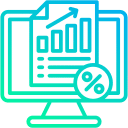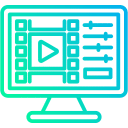Imagine being able to track every aspect of your team’s performance seamlessly, identify growth opportunities, and offer tailored development plans all in one place. Sounds like a dream, right? With an effective Learning Management System (LMS) for performance management, this is a reality.
Performance management goes beyond just assessing employee outcomes; it’s about fostering continuous growth, development, and engagement.
This blog will explore how LMS performance management tools can revolutionize your approach to tracking employee performance, ensuring productivity, and maximizing potential.
What is LMS Performance Management?
LMS performance management is the integration of performance tracking and evaluation features within a learning management system. It provides organizations with tools to monitor, assess, and guide employees throughout their development journey.
A robust LMS helps businesses track individual and team performance, align objectives with company goals, and provide targeted learning experiences based on performance gaps.
Rather than using disconnected systems for performance tracking, an LMS with integrated performance management brings everything together in one unified platform, increasing efficiency and streamlining your employee management process.
How LMS Performance Management Drives Employee Growth
Performance management is no longer just about annual reviews. It’s a continuous, proactive process that focuses on employee development throughout the year.
By leveraging an LMS, you can create a more dynamic and personalized learning environment that not only tracks performance but actively promotes growth and improvement.
1. Continuous Feedback for Ongoing Development
One of the challenges of traditional performance reviews is that feedback is often too infrequent. With LMS performance management, feedback becomes a regular part of the employee experience. Managers can provide real-time insights and constructive feedback, enabling employees to adjust their actions and continually improve.
This ongoing feedback loop helps employees feel more engaged and empowered. They can immediately apply suggestions and track their progress over time, leading to more rapid growth and development. An LMS also allows managers to set up automated feedback triggers based on specific milestones or goals, making it even easier to monitor and assist employee progress.
2. Personalized Learning Paths Based on Performance
One of the key benefits of using an employee performance tracking LMS is its ability to create personalized learning paths for each employee. Based on performance evaluations, you can design training programs tailored to individual needs, ensuring that every team member gets the support they need to improve and excel.
For example, if an employee is struggling with a specific skill, the LMS can suggest or automatically assign training modules focused on improving that area. Personalized learning pathways not only help employees overcome challenges but also encourage continuous learning, keeping employees engaged and committed to their personal development.
3. Data-Driven Insights for Better Decision Making
Having access to performance data in real time allows managers to make informed decisions quickly. With LMS performance management tools, you can analyze employee performance trends, identify high performers, and spot areas that need improvement.
These insights enable managers to take a more proactive approach to employee development, offering targeted support where it’s most needed. This data-driven approach eliminates guesswork and ensures that training and development initiatives are aligned with actual performance needs, making them more effective and impactful.
4. Goal Alignment and Tracking
Setting clear goals and tracking progress is crucial for employee growth. An LMS with performance management capabilities allows you to align employee goals with broader organizational objectives. By creating clear, measurable goals and using the LMS to track progress, you ensure that employees are always working towards the most important targets.
The LMS makes it easy to track the progress of both individual and team goals, providing a transparent view of achievements and areas for improvement. This fosters accountability and helps keep employees motivated as they see their progress over time.
Key Features of an Employee Performance Tracking LMS
To optimize performance management, your LMS should include specific features that support tracking, feedback, and development. Let’s take a look at the core functionalities that will elevate your performance management process.
1. Real-Time Performance Analytics
Analytics dashboards within the LMS give you instant access to key performance indicators (KPIs) that allow managers to gauge the success of training programs and identify employee progress. These dashboards present data in an easily digestible format, making it easier for managers to monitor team performance.
2. Customizable Performance Review Templates
Instead of relying on generic performance reviews, a performance management LMS offers customizable templates that align with your company’s unique evaluation criteria. Managers can assess employees based on specific competencies, behaviors, and goals, leading to more accurate and relevant performance reviews.
3. Self-Assessment Tools
Empowering employees to assess their own performance is another great way to encourage growth. Self-assessment tools within the LMS allow employees to reflect on their own progress, set personal goals, and gain deeper insights into their strengths and areas for improvement.
By making self-assessments a regular part of the performance management process, employees are more likely to take ownership of their development, leading to increased accountability and motivation.
4. Automated Learning Assignments
Based on performance evaluations, automated learning assignments can be triggered, ensuring that employees are always working on the right courses or training modules to improve their performance. This integration helps streamline the training process, ensuring that employees receive the appropriate resources for their development.
Why Use an LMS for Performance Management?
Traditional methods of performance tracking, such as spreadsheets or standalone software, can be disjointed and inefficient.
Here’s why using an LMS for performance management is far superior:
- Centralized Data: All performance tracking data is stored in one place, making it easy to access, review, and act upon.
- Real-Time Tracking: LMS performance management allows for ongoing performance tracking, enabling you to make adjustments and interventions when needed.
- Consistency: Performance reviews and feedback are standardized and consistent across the organization, ensuring fairness and clarity in employee assessments.
- Scalability: As your company grows, your performance management system can scale alongside it, accommodating new employees and roles seamlessly.
Challenges to Consider When Implementing an LMS for Performance Management
While the benefits of an LMS for performance management are clear, it’s important to acknowledge potential challenges. Here are a few things to consider before implementing such a system:
1. Integration with Existing Systems
If you already use other HR tools or platforms, integrating your LMS with these systems might require additional work. However, most modern LMS platforms support integration with other software, making the process smoother. Ensure your LMS can sync with your HR software, payroll system, and other tools to maximize efficiency.
2. Employee Adoption
Some employees may be hesitant to embrace new performance management tools. To overcome this, provide proper training on how to use the LMS and its performance management features. When employees see the benefits, such as personalized feedback and clear career development paths, they’re more likely to engage with the system.
3. Customization and Configuration
While LMS platforms offer various templates and tools, it’s important to customize the system according to your organization’s specific needs. This could mean adjusting performance review forms, creating custom learning paths, or defining specific KPIs. Ensuring that the LMS aligns with your company’s objectives will improve its effectiveness.
Conclusion: Empower Your Workforce with LMS Performance Management
Integrating performance management within your LMS is a powerful way to boost employee growth and productivity. By providing continuous feedback, personalized learning, and data-driven insights, you create a culture of continuous improvement.
The right LMS can help track performance, set clear goals, and equip your employees with the resources they need to excel.
So, are you ready to take control of your performance management process? Start exploring LMS solutions that integrate performance tracking and elevate your team’s development. Your organization’s growth and success depend on it!












